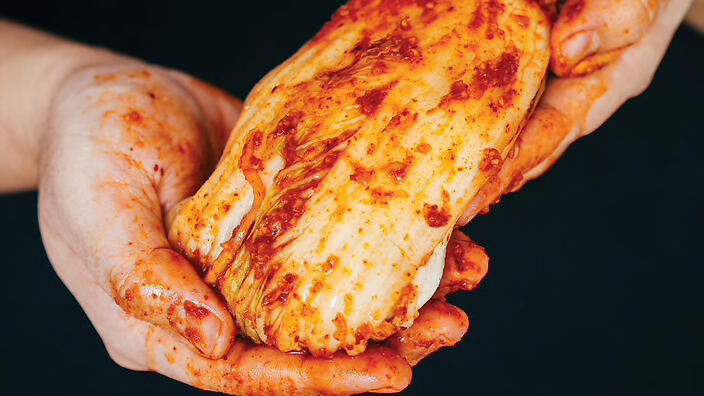Cabbage_kimchi_(baechu_kimchi)
Cabbage kimchi (baechu kimchi)

Almost every household in Korea will have a jar of cabbage kimchi sitting in the fridge or in an underground cellar, fermenting away. And every family will have their own closely guarded secret recipe for the best kimchi.
Ingredients
1 Chinese or napa cabbage (about 2 kg/4 lb 6 oz) 315 g (11 oz/1 cup) coarse cooking salt 450 g (1 lb/2 cups) Korean radish, peeled 4 spring onions (scallions)
Kimchi chilli paste cloves from 1 garlic bulb (about 10), peeled 2 cm (¾ in) piece of ginger, peeled 1 onion, quartered 40 g (1½ oz/½ cup) Korean chilli flakes (gochugaru) (see Notes) 125 ml (4 fl oz/½ cup) fish sauce 1 tbsp caster (superfine) sugar
Instructions
Makes about 2.5 kg Pickling time: 4 hours Marinating time: 1 hour Fermenting time: at least 2 days
First, make the kimchi chilli paste (see Notes). Put the garlic, ginger and onion in a blender or food processor and blend on high speed to form a fine paste. Transfer to a large mixing bowl. Add the chilli flakes, fish sauce and sugar, and stir until the sugar has dissolved. Use immediately or store in an airtight container in the refrigerator up to 2 weeks. Halve the cabbage lengthways from root to tip. Cut each half in half again so that you end up with quarters. Give the cabbage segments a quick wash and tease the leaves apart gently from the core, being careful not to tear them, and rinse to remove any dirt. Shake off any excess water and set aside. Working with one quarter at a time, place the cabbage on a flat surface with the outermost leaf on the bottom. You will need 80 g (2¾ oz/¼ cup) salt per quarter. Starting from the bottom leaf, generously sprinkle salt over the thickest parts of the cabbage, using less salt on the leafy parts. Place the salted cabbage segment in a large mixing bowl. Repeat with the remaining cabbage and salt. Once all the cabbage segments are salted and sitting in the bowl (stack them on top of each other if necessary), pour in 1 litre (34 fl oz/4 cups) water. Press down to ensure the segments are completely covered, then set aside to pickle for 4–6 hours. Every 1–2 hours, rotate the cabbage segments to ensure each piece is thoroughly coated in the pickling liquid. The cabbage is ready when the thickest parts are soft and bendable. Thoroughly rinse the cabbage under cold running water three times. Squeeze each segment to remove as much water as possible then transfer to a colander, cut side down, to drip-dry while you prepare the chilli paste. Cut the radish into matchsticks about 5 mm (¼ in) wide and 5 cm (2 in) long. Place in a large bowl. Cut the spring onions into 2.5 cm (1 in) lengths and add to the bowl. Add the kimchi chilli paste and stir until well combined. Set aside for 1 hour to marinate. After an hour, the radish will have softened and you should have a loose, wet paste. Transfer the cabbage segments, cut side up, to a baking tray. Working with one segment at a time, spread one-quarter of the radish chilli paste evenly over the cabbage leaves, starting from the outermost leaf. Wear food preparation gloves if necessary to protect your hands from the chilli. Once the cabbage is well coated in the chilli paste, fold the leaf part of the cabbage over towards the stem to form a nicely wrapped parcel. Transfer the parcel, cut side down, to an airtight container. Repeat with the remaining cabbage segments, packing each one snugly into the container. Rinse the baking tray with 60 ml (2 fl oz/¼ cup) water to loosen any leftover chilli paste. Add any loose cabbage leaves to the tray, stir briefly, then pour everything into the container over the cabbage segments. Seal the container with a lid. Place the container in a cool spot away from direct sunlight and leave to ferment for 2 days. The kimchi will ferment more quickly during the summer and more slowly during the cooler months. After 2 days, pack each cabbage segment into a mason jar, seal tightly, and store in the refrigerator. The kimchi will be ready to eat after 2 days, but the flavours will continue to develop the longer it is stored. When you are ready to eat, remove the kimchi from the jar. Use a pair of kitchen scissors to cut off as many leaves as you want, then return the remaining cabbage to the jar. Cut the kimchi into 2.5 cm (1 in) pieces to serve.
Notes • Gochugaru, or Korean chilli flakes (also called Korean chilli pepper powder), is widely used in Korean dishes. It usually comes in two forms: coarse chilli flakes or fine powder and is available from Asian grocers. • This paste is very pungent because of the amount of garlic used. You can use less garlic if you don’t want it to be too strong. • The kimchi keeps well in the fridge for a minimum of 1–2 months. If it has turned mouldy and fizzy, discard it.